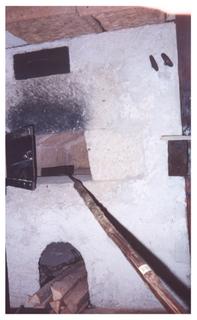 |
Top - Wicker trays, Trockernhurten, for drying greens and fruit
Middle - Bake oven door with Kiss rake
|
"In the corner is a complete bake oven, in which bread was baked in former times. The glowing ash was pulled out of the hot oven with the Kiss (a long-handled type of rake). With the Brotschiess (literally this is a bread shooter), the loaves of dough were quickly pushed into the oven and the finished bread pulled out with the same device. Once the oven was empty, the Trockernhurten (a woven drying rack) went in. On it might be greens for soup, little plums, or apples and pears cut in strips for drying."
"In the Muhle (a bread trough which could also be covered and used as a table), the bread dough was prepared for baking. If the dough had risen, it was put into the Kurbeln (a woven, round basket) and covered with a white linen cloth and left to rise for approximately10 hours. In former times they said the 'bread must steam'. When the Muhle was emptied, any remaining dough was scraped together and formed into a ball. This dough had to be kept at a place in the room where the temperature was always the same. It was covered with a white linen cloth and fermented for the next 10 days. That became the Sauerteig (leaven) for the next bread"
 |
| Henkelmänner |
"Here are various Henkelmänner (lunch buckets). In former times during the potato and grain harvest, the meal was taken to the workers in the field in these Henkelmänner. There is a difference between the normal Henkelmänn and the Marmittchen (taken from the French word for a pot called the Marmit). The Marmittchen consists of several small pots stacked one above the other. This made it possible to transport and keep several meals divided. In the large Henkelmänn there was only an Eintop (a single pot). In the Fresskorb" (lunch basket), children brought an afternoon lunch (bread and so forth) to the fields after school. Coffee was carried in the Zigeunerkanne or gypsy jug. The popular homemade drink, Viez, was kept cool in the Viezbombel made of stoneware."
"In the farm kitchen, the floor is made of stone, usually this was sandstone. The open chimney is above the hearth. The cast-iron pot hangs on a rod that can be raised or lowered depending on the amount of heat needed. Ham, bacon and sausages were smoked in the open chimney."
No comments:
Post a Comment